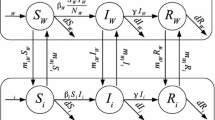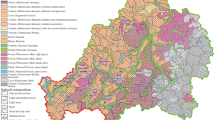Abstract
The influence of topographical situation on the spread of infection is studied. The investigation is based on a multigroup model. The population under consideration is thought to be divided into subpopulations living in regions that are separated from each other by natural barriers (mountains). Infection is carried from one region to another by migrating infectives. Migration is possible only along the river system so that the structure of the epidemiological network is that of a symmetric tree. The results allow comparison of the velocity of propagation of the epidemic for different geographical situations and allow quantification of the “channel-effect”, according to which mountainous regions are channels rather than barriers to the spread of an epidemic.
Similar content being viewed by others
Literature
Anderson, R. M., H. C. Jackson, R. M. May and A. D. M. Smith. 1981. “Population Dynamics of Fox Rabies in Europe.”Nature 289, 765–771.
Bacon, P. J. and D. W. Macdonald. Eds. 1981. Habitat Classification for Fox Populations and Rabies Spread. Merlewood Research and Development Paper No. 81. Institute of Terrestial Ecology.
Bailey, N. T. J. (1975).The Mathematical Theory of Infectious Diseases. London: Griffin.
—. 1979. “Spatial Models in the Epidemiology of Infectious Diseases.” InLecture Notes in Biomathematics. No. 38, pp. 233–261. Berlin: Springer.
Berger, J. 1976. “Model of Rabies Control.” InLecture Notes in Biomathematics. No. 11, pp. 74–88. Berlin: Springer.
Dietz, K. 1976. “The Incidence of Infectious Diseases under the Influence of Seasonal Fluctuations.” InLecture Notes in Biomathematics. No. 11, pp. 1–15. Berlin: Springer.
Kermack, W. O. and A. G. McKendrick. 1927. “Contribution to the Mathematical Theory of Epidemics.”Proc. R. Soc. A 115, 700–721.
Krocza, W., E. Scharfen and G. Mandl. 1981. Landscape and Wildlife Rabies in Austria (1966–1979). WHO paper VPH/RAB/81.4 (WHO consultation on natural barriers of wildlife rabies in Europe, Vienna 1981).
MacDonald, D. W. 1980.Rabies and Wildlife; a Biologist's Perspective. Oxford: Oxford University Press.
Steck, F., A. Wandeler, B. Bydegger, C. Manigley and M. Weiss. 1980. “Die Tollwut in der Scheiz 1967–1978.”Schweizer Arch Tierheilk. 122, 605–636.
Author information
Authors and Affiliations
Rights and permissions
About this article
Cite this article
Timischl, W. Influence of landscape on the spread of an infection. Bltn Mathcal Biology 46, 869–877 (1984). https://doi.org/10.1007/BF02462075
Received:
Revised:
Published:
Issue Date:
DOI: https://doi.org/10.1007/BF02462075




